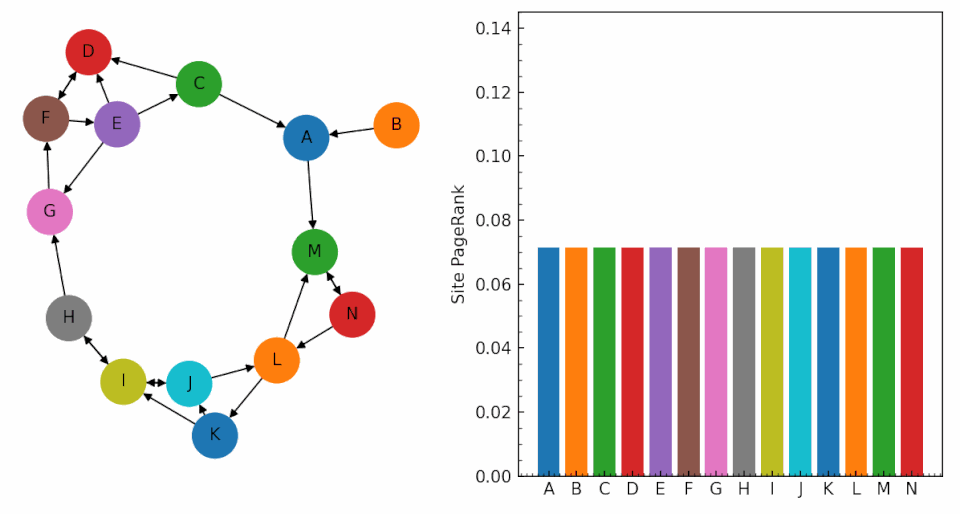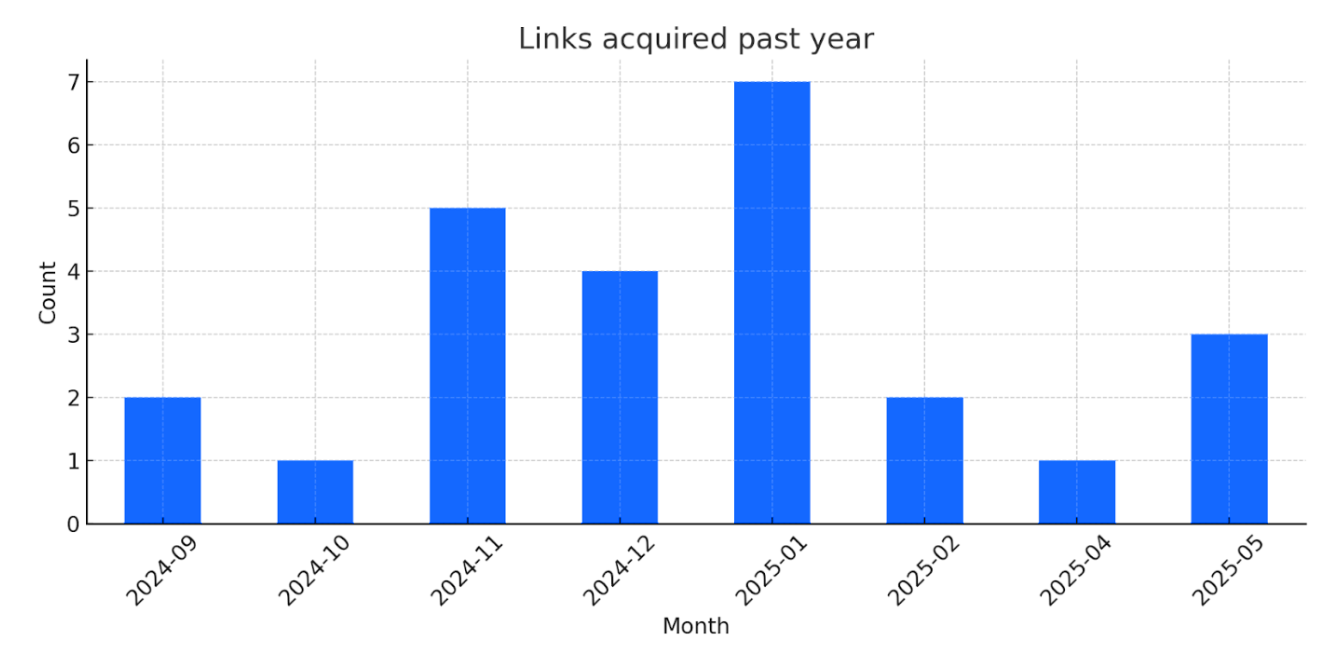What are white hat and black hat link building tactics?
There are some ‘white hat link building tactics’ and there are some ‘black hat link building tactics’, over time the white hat ones have become more impactful and they are the ones we will be looking at today. White hat tactics are ones that will never result in a manual action penalty in Google and are not against guidelines, black hat refers to several tactics (think buying loads of backlinks and spamming directories) that could get you deindexed due to policy violations.
If you are looking to learn about black hat link building, then I suggest checking out this guide from Linkbuilder.io which goes into plenty of detail. If not, then keep reading to learn more about link building and how to do it the right way.
The fundamentals of link building
Do you remember a time before Google? I do (just about) and the different search engines vying for users all had one problem; getting the best results to the top of the index. As the engines often focused on the pure contents of the page (after evolving from more of a directory style approach) it meant in many instances a mismatch between user intent and the content. Enter links, or specifically, Pagerank from Google in 1996.
When Google launched in the late 1990s, links formed the backbone of its PageRank algorithm. Each link acted as a vote of confidence, signalling trust and authority. Early ranking was heavily based on quantity, which led to link farms and manipulative schemes. Google refined its systems over time, with updates like Penguin in 2012 penalising unnatural patterns and rewarding links that were editorial and relevant.

Source: Wikipedia
In 2025, link building is firmly quality-first. Search engines prioritise links that show topical relevance, authority and user value, while ignoring low-quality ones. Digital PR has become a leading strategy, with brands using campaigns, studies and expert commentary to win high-authority placements. There is also a growing focus on earning links through assets like tools, guides and visuals. Measurement has shifted too, with marketers assessing not just referring domains but also the traffic and visibility links bring. The emphasis is now on sustainable, brand-aligned strategies.
How to judge the value of a link
Judging the value of the link has, much like the rest of SEO, evolved over time. For many, judging the value of a link begins and ends at Domain Authority. This metric was developed by the SEO company Moz as a way of judging how likely a website is to rank in search based on quality, quantity and relevance.
Whilst it is a great metric and in many instances driving links based purely on it can still generate links that move the needle, there are a number of other metrics useful when it comes to sorting a good link from a bad link.
Page Authority / URL Rating (PA/UR): strength of the specific page linking to you.
Relevance: how closely the linking site and page match your topic.
Traffic: estimated organic visits to the linking page or domain.
Anchor text: the wording used in the link and whether it is natural and relevant.
Co-occurring text: the text that appears around your anchor text to add context
Placement: whether the link sits in the body content, navigation, footer, or sidebar.
Follow vs. nofollow / sponsored: whether search engines will pass equity through the link.
Link diversity: whether the link comes from a unique domain or repeats an existing one.
Outbound link profile: how many other sites the page links to and their quality.
Indexation: whether the linking page is indexed in Google and can pass value.
Engagement signals: likelihood that users will actually click the link (context, visibility).
The Varn Score takes into account the above metrics in combination (with a big focus on relevance) and acts as a scoring system when we are conducting outreach and also looking to measure the results of our work. It’s also a very important first step to take before you dive into the actual link building tactical playbook.
The link building tactical playbook
Okay, we have the fundamentals of why links are important and the tools needed to judge good links from bad. Now lets dive into the actual link building tactics we use to earn coverage for all our lovely clients:
Digital PR campaigns
Digital PR is one of the most impactful link building tactics because it generates authoritative, editorial links from major publications. By creating newsworthy campaigns, original data studies, or expert commentary, you can secure links that not only improve rankings but also build brand visibility and trust. These links are hard for competitors to replicate, making them especially valuable. Read the full guide to digital PR here.
Update for 2025: Another important element to consider when conducting digital PR is AI citability; many news sites are opting to block AI crawlers from their site, so if you have coverage on these sites, they may not be as impactful when it comes to earning coverage in AI (which isn’t to say you shouldn’t pitch to them, just make sure you are not only pitching to them!).
Resource page link building
Authoritative sites often publish curated resource lists. By identifying a page that is missing your guide, tool, or explainer, you can pitch it as a valuable addition. Since these links are highly contextual and relevant, they often bring both SEO equity and referral traffic from users seeking practical resources.
Listicle link building
Listicles (“Top 10 X”, “Best of Y” types) are popular and shareable, making them fertile ground for link placements. You can pitch to be included in relevant listicles or build your own list-style asset that others cite and link back to you. These are also getting increasingly cited within AI.
Broken link building
This tactic works by helping site owners fix broken outbound links. Once you find a 404 link on a relevant site, you can suggest your own up-to-date content as a replacement. Because you are solving a problem for the webmaster, the pitch feels helpful and increases your chances of success.
Wikipedia / authoritative reference links
Contribute to Wikipedia (or authoritative reference sites) by adding citations to your content in places where it genuinely adds value. These links are nofollow in many cases, but they can generate exposure and serve as a seed for other sites to link to you
Skyscraper technique
The skyscraper approach involves creating a significantly better version of an existing piece of content that already has backlinks. Improvements could include fresher data, deeper analysis, better visuals, or a clearer structure. When you contact sites linking to the older resource, you can present your page as a stronger alternative. Our article on how to write content that gets links can be found here.
Link placements
This method involves working directly with bloggers or publishers to optimise their existing content in exchange for adding your link. Often this includes updating statistics, improving copy, or suggesting helpful resources that enhance their article. When done transparently with relevance in mind, it is a win-win that strengthens their page and earns you a contextual backlink.
Unlinked brand mentions
Websites often mention a brand without linking to its homepage or relevant resource. By tracking these mentions, you can request a link so readers can click through to the original source. Since the site already acknowledges your brand, the conversion rate on these outreach requests is usually high.
Reverse image search link building
If your visuals, charts, or infographics are used online without credit, you can identify these cases through reverse image search tools. A polite outreach message requesting attribution often results in a backlink to the original source. This tactic is particularly effective if you regularly produce shareable visual assets. Read more about this tactic and unlinked mentions here.
Guest posting
Publishing guest articles on other sites allows you to position yourself as an authority while earning a backlink. It is most effective on niche-relevant, high-quality blogs where your contribution adds real value. Overuse or mass guest posting can dilute results, so focus on select placements with strong editorial standards.
Local and community sponsorships
Sponsoring local events, charities, or community projects is a straightforward way to earn links from trusted sites. These backlinks may not carry high authority but they are excellent for local SEO signals and for building relationships with community stakeholders.
Directory and citation links
Foundational links from directories and citation platforms help establish legitimacy. They are especially important for local businesses to reinforce NAP (Name, Address, Phone) consistency across the web. While these links are low impact for rankings, they are useful for credibility and discovery.
The link building process
We now have the tactics down, it’s time to get into the outreach process. Over time tools have greatly scaled the market when it comes to emailing and cold outreach, getting the right balance between personalisation and a wide enough pool of contacts is crucial. I have detailed a general process below and will call out specific elements where there are differences between the tactics (e.g prospecting for broken links is very different to prospecting for digital PR contacts).
Step 1: Define the goal
Decide what you want to achieve with your outreach: for example, securing backlinks for a new guide, reclaiming brand mentions, or getting included in a listicle.
Step 2: Identify target pages
Use tools (Ahrefs, Semrush, Google search operators, reverse image search) to find websites or pages that are relevant to your content and suitable for a link.
Step 3: Qualify and prioritise prospects
Evaluate the potential sites using metrics like domain authority, topical relevance, traffic, and outbound link quality. Prioritise the ones that offer the highest value. This is where the different tactics have their own nuances:
Digital PR: If you are pitching a story, find the right journalist contacts based on the content you are pitching.
Resource link building: Find the content online by using modifiers in Google (keyword inurl: resources keyword “statistics”). From this look for the relevant webmasters and start to gather contact details.
Guest posting: Find sites online that are open to guest content (search with modifiers containing guest blogs etc) and create a list of good quality websites (considering the link evaluation criteria we outlined earlier).
Step 4: Find contact details
Locate the most appropriate contact person (editor, webmaster, journalist, blogger) and capture their email address, LinkedIn, or submission form details.
Step 5: Prepare personalisation hooks
Read their content and note specific details you can mention — recent posts, broken links, outdated data, or places your resource adds value.
Step 6: Draft tailored outreach messages
Use short, clear, and polite emails that explain the benefit to them and their readers. Avoid generic templates; adapt your core script for each outreach type.
Step 7: Send the first email
Keep the subject line concise and the body focused on value. Include one call to action (add, update, include, or cite your resource).
Step 8: Follow up
If no reply after 3–5 days, send a polite nudge with a slightly different angle. Limit follow-ups to two or three in total to avoid spamming. As part of managing your outreach pipeline, it’s also essential to validate email addresses periodically to ensure your messages actually reach the intended recipients. High bounce rates can weaken your sender reputation and limit deliverability, which means even the best outreach strategy won’t perform if your contact list is outdated. Using a free email address verification tool helps maintain a clean prospect list and improves the overall success rate of your link building campaigns.
Step 9: Track responses and outcomes
Log replies, positive responses, rejections, and successful link placements. Use a spreadsheet or outreach tool (Pitchbox, BuzzStream, Hunter) to stay organised.
Step 10: Build relationships
When you secure a link, thank the contact. Stay connected by sharing their content, offering future help, or engaging with them on social platforms. This builds long-term value beyond a single link.
Step 11: Measure results
Review link metrics (referring domains, anchor text, page traffic) and track the overall impact on rankings and visibility. Use this data to refine future outreach.
Forecasting
When it comes to link targeting and forecasting, you can take industry standard benchmarks and look to extrapolate out link targets from there. Say for example you have 100 prospects, and a 20% open rate with your email outreach (which is a pretty good one to aim for when it comes to this cold outbound approach).
From that you have 20 responses, great. If you can convert 25% of them, you have 5 links, on the low end and if you can convert 50% that’s 10 on the higher end. So you know if you email 100 prospects every month, you can expect between 5-10 links a month on average. Of course if you spend more time personalising each email, there is every chance you can get those percentages higher, but it’s a good methodology to work from.
Another way to forecast results for resource pages and inbound link building can be done with a software tool like SEMRush. If you are conducting a skyscraper campaign, you know that a certain bit of content may get a certain number of links a month. If you can get ahead of that competitor content, you can start to get a gauge on the number of links that you can expect to acquire.

Looking to engage in link building for SEO/GEO?
Link building can be a time consuming process, but with the right partner you can scale it and achieve some pretty remarkable results. If you want to learn more about our process and how to leverage agentic AI to get your campaigns driving the best results then get in touch with a member of the off-page SEO team today.
FAQs on link building
The number depends on your competition. Check the top-ranking pages for your target keyword, note the median number of referring domains they have, then aim to close that gap with quality, relevant links rather than chasing a fixed number.
Low-competition terms may move within weeks, but most competitive keywords take three to six months. Search engines need time to discover, crawl, and evaluate new links.
Editorial links placed naturally in the body of relevant, high-authority pages tend to carry the most weight. These are often earned through Digital PR, resource pages, or strong linkable assets.
No. While nofollow links may not pass PageRank directly, they can bring referral traffic, brand visibility, and even lead to other sites linking with followed links.
Google discourages buying links that pass authority. If you do engage in paid placements, mark them with rel=”sponsored” to avoid risks. Safer long-term strategies are Digital PR, content-led outreach, and reclamation tactics.
Direct links to commercial pages are harder to secure. The best approach is to earn links to supporting assets (guides, tools, research) and then use internal links to pass value through to product or service pages.
Domain authority estimates the ranking strength of an entire site, while page authority looks at a specific page. A strong link from a high-authority domain is useful, but links from pages with authority and traffic tend to have the most impact.
Monitor referring domains, anchor text distribution, link placement quality, and traffic from linking pages. Pair these with ranking changes on your target keywords for a complete picture.
You can start with a base template, but personalisation is critical. Tailor your message to the site owner’s content, show genuine value, and keep it short and polite.
The biggest mistake is chasing quantity over quality. A handful of relevant, high-value links will always outperform hundreds of low-quality directory or paid links.
